by
K.A. Savvaitova
Faculty of Biology, Moscow State University, Vorobevy Gory, Moscow, 119899 Russia
and
T. Petr
27 McLeod Street, Toowoomba Qld 4350, Australia
Native fish stocks in the high-altitude saline Lake Issyk-kul (altitude 1608 m) in Kyrgyzstan have been subjected to predatory pressure from the introduced Sevan salmon (Salmo ischchan gegarkuni). Due to its oligotrophic character, the lake has low fish yields. The rapid growth in human population, development of tourism around the lake, increasing eutrophication and high demand for fish have necessitated a new assessment of the existing fishery and formulation of new fishery strategies. The best response to the current trends in the changing environment is to concentrate on the development of fish stocks to satisfy recreational fishery, while gradually reducing the commercial fishery. South of Lake Issyk-kul are the high mountains of the Pamir. Four of the existing several hundred lakes, all situated from 3220 m to 4260 m altitude, have a medium productivity. Their fish yield estimates range from 20.4 to 39.6 kg ha-1. Such lakes offer good conditions for fish feeding on zooplankton, and in some lakes the northern whitefish (Coregonus peled) have been stocked. Few of these lakes are fished at present. It has been suggested that some of the Pamir lakes serve as sanctuaries for the preservation of coldwater fish species which are threatened in their original habitat. In the River Chu (Kyrgyzstan/Kazakhstan) damming, water diversion for irrigation and increased water salinity in its lower course as a result of the reintroduction of drainage waters from irrigation, have had a negative impact on the indigenous coldwater fish stocks. The present fish production in reservoirs and fish ponds, achieved through management efforts, produces about the same quantity as before the indigenous fish loss, but at a much higher cost.
High altitude water bodies in Central Asia, including lakes of Tien Shan and the Pamir, are characterised by low water temperatures, high transparency, great depth and some other characteristics typical of water bodies of low productivity. This paper reviews the fish stocks and fishery management measures taken in order to increase fish yields and to improve the quality of fish produced in the saltwater Lake Issyk-kul in Kyrgyzstan (Fig. 1), and in lakes of the Pamir. Formation of reservoirs on the River Chu in Kyrgyzstan/Kazakhstan has provided the fishery managers with the task of forming lacustrine communities in lieu of the riverine fish stocks.
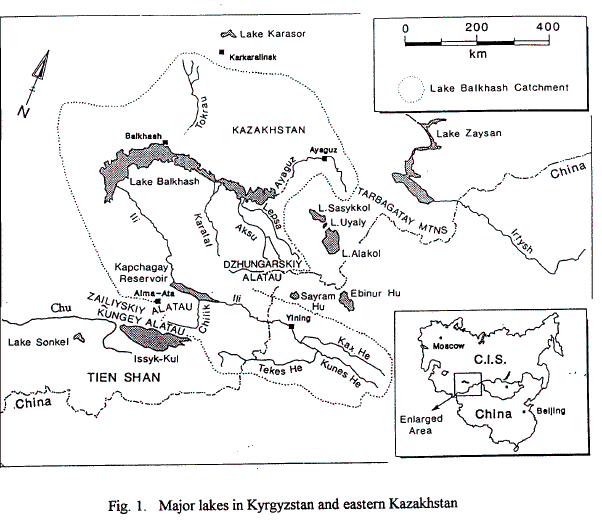
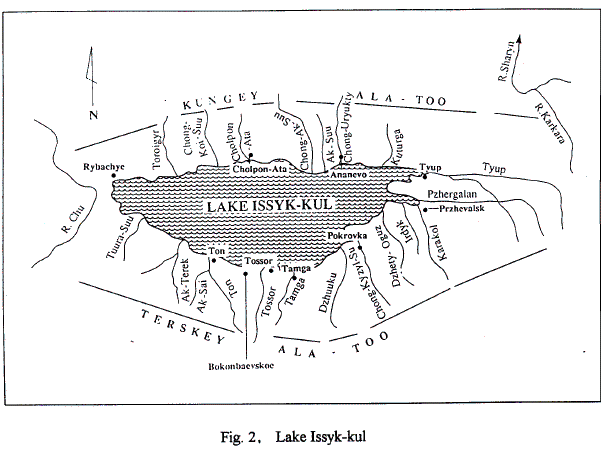
2.1 Physico-chemical environment
Lake Issyk-kul (Fig. 2) in Kyrgyzstan is situated in a basin surrounded by high mountains. While its water level is at 1607.9 m altitude, the mountain ranges of Kungei Ala-Too in the north reach 4700 m, and those of Terskei Ala-Too in the south reach 5200 m. These mountains represent the major part of the Issyk-kul catchment of 22,080 km2 and provide much of the water to the lake. Formerly 102 rivers and streams reached the lake, but 29 had discharges <1 m3 s-1. Rivers are fed predominantly by meltwater from glaciers and snow above 3300 m. Water of a number of rivers has been completely diverted for irrigation before it enters the lake. The rivers supply the lake with 3720 million m3 of water per year (Zabirov and Korotaev, 1978) but they are not the only water supply the lake is receiving. The annual surface water discharge, precipitation and groundwater discharge to the lake are 208, 289, and 330 mm respectively, the evaporation from the lake is 820 mm. For more details see Savvaitova and Petr (1992).
Issyk-kul is 178 km long and 60.1 km wide, its surface area is 6236 km2, and the shoreline is 669 km. The mean depth is 278.4 m, and maximum depth 668 m (Kodlyaev, 1973). The area covered by a depth of 0-10 m represents 38.4% of the total area. This is the major production zone of the lake.
The lake water level is subject to considerable fluctuation, both within the same year and over longer periods. Berg (1929) suggested that the long-term rise and fall depended on the variation in the climate. Until recently, there was a downward trend: over the period between 1876 and 1972 the water level declined by 9 m (Shnitnikov, 1979). From 1973 to 1981 the water level was dropping at a rate of 7-10 cm per year (Konurbaev, 1981), and it was suggested that by the year 2000 the lake surface area would reduce by a further 12,000 ha (Shnitnikov, 1979). However, since 1986 the decline in water level has stopped and the lake level has started to rise again.
The annual variation in the lake water level is 20-25 cm, with the minimum level reached in March or February, and the maximum in August/September. In years with poor rainfall the maximum is reached already in June/July.
The chemical composition of the lake (mg l-1) is as follows (Kadyrov, 1986): Ca - 121, Mg - 287, Na+K - 1544, Cl - 1596, HCO3+CO3 - 318, SO4 - 2102. Total cations: 1952, total anions 4016; salinity 5.968 g l-1. For more details see Savvaitova and Petr (1992).
The pH ranges between 7.7 and 7.9. Water is well oxygenated because it is regularly mixed by strong winds. During the warm period of the year, the surface water moves from the central part of the lake towards the shores and it is replaced by deep cool water. In the middle of the lake the water is stratified down to 5-10 m whereas near the shores the thermal discontinuity is at a depth of 20-30 m owing to the warm water inflow. Apart from the central upwelling there are also lateral upwellings, caused by the wind which drives surface water from the shore to the open parts of the lake (Shabunin,1981). Two major currents, driven by two wind streams, can almost always be observed: one follows the northern shore in a westerly direction, the other flows east along the southern shore. Secchi disc transparency ranges from 30-47 m in the open lake, being reduced to 0.5 m at the mouths of the inflowing rivers.
The bottom configuration is variable and this results in a diversity of habitats. In the western part of the lake there is a wide belt of shallows. Along the northern shore the shallows are separated by underwater depressions and canyons which are remnants of both past and present rivers (Zabirov, 1978). Two larger rivers, Dzhergalan and Tyup, enter the lake in the east, and their canyons cut deep into the lake bottom far offshore.
Although located at a high altitude, Issyk-kul never freezes over, except in the Rybachinsky and Tyup bays. The water stays warmer than the air for a number of months. In summer the surface water temperature in the central part reaches 18oC, in winter it is seldom above 4oC (Berg, 1930). The temperature may drop by 12-14oC down to 50 m depth and a further 1.5-2oC to the depth of 100 m. The water layer at 100-200 m depth maintains almost a stable temperature, with changes kept within 0.1-0.3oC (Molchanov, 1946).
2.2 Biological features
Issyk-kul is rich in phytoplankton, with 299 taxa identified. Blue-green algae (Cyanophyceae) dominate, but their standing crop is low. Macrophytes extend to 1.5 m depth and attached algae to 30-40 m. Characeae are the most common macrophytes, representing 96% of the total annual macrophyte production, and are present in almost all plant associations. Four species of Chara grow in shallow water, and three species at a greater depth (Savvaitova and Petr, 1992).
Zooplankton includes 117 taxa and is dominated by rotifers (98), followed by cladocerans (11) and copepods (8). Zooplankton and phytoplankton distribution in the lake is uneven, with bays and shallows being richer than open water. Arctodiaptomus salinus is present in all parts of the lake and over the year it may represent 75-95% of the total number of zooplankton and 95-99% of the biomass. This species migrates during the night into the surface water where its concentration reaches up to 35,000 ind. m-3 (Foliyan, 1981), thus representing an important food source for some fish.
Zoobenthos comprises 224 taxa. Most benthos occurs between the shoreline and 40 m depth, in the Charophyta zone. The mean annual biomass of zoobenthos is 8-10 g m-2. Chironomids, molluscs, gammarids and mysids comprise 6-8 g m-2 of the total. In the deeper zone beyond the zone of Characeae and down to about 70 m, the biomass is 2.5-3.5 g m-2 and is dominated by chironomids and the mollusc Radix auricularia. Three mysid species introduced into Issyk-kul from Lake Balkhash in 1965-1968 are now permanently established in shallows, mostly in 1.5-1.8 m depth, but reaching down to 10 m. Their mean biomass in such waters is 1.5-2.5 g m-2 (Ivanova, 1986).
2.3 Fish fauna
The original fish fauna comprised several endemic taxa (Table 1). The common fish dace (Leuciscus schmidti) is present throughout the littoral zone and down to 35-40 m. It appears in two forms, a common fast-growing lake form and a slow-growing bay form. The fast-growing form reaches 31 cm, a weight of 650 g, and age of 11 years. It spawns on stony beds at depths of 0.5-10 m between the end of March (water temperature 5oC) and mid-May. Fecundity is 6,000-65,000 eggs. It feeds largely on Characeae. The slow-growing form is present throughout the shallows. It reaches a length of 23 cm, a weight of 220 g, and a maximum age of 13 years. It spawns on the same substrate as the other form, but later. It has a similar fecundity to that of the other form.
Until the early 1970s, L. bergi was the dominant fish in the lake. It was found down to depths >100 m, and reached a maximum body-length of 16.5 cm and weight of 60 g. During recent years, however, the number and distribution of this species have sharply declined. Of the three types, i.e. the inshore, the semi-migratory and the fast-growing, the first two declined the most. Leuciscus schmidti has a biology similar to that of L. bergi, but the former species seeks food in deeper water and prefers feeding on plankton.
The indigenous scaleless osman (Dyptichus dybowskii) appears in two forms: D. dybowskii in rivers and a subspecies D.d. lansdelli in the lake. The subspecies appears in a
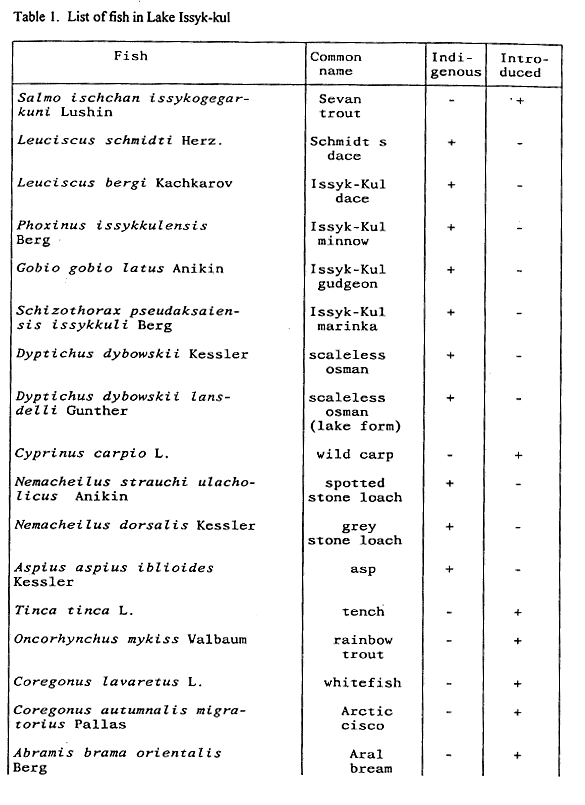
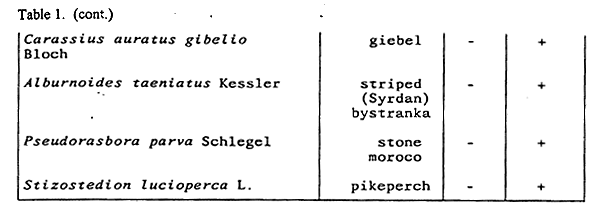 winter lake form and a summer migratory form which spawns in rivers. The winter form spawns from February to April and its fecundity is 13,000-14,500. The summer form is smaller, has a fecundity of 5,500-12,000, and spawns from April until September (Berg, 1949; Turdakov, 1963). Both forms are omnivorous. Until the 1970s, scaleless osman was common and the major component of capture fisheries.
winter lake form and a summer migratory form which spawns in rivers. The winter form spawns from February to April and its fecundity is 13,000-14,500. The summer form is smaller, has a fecundity of 5,500-12,000, and spawns from April until September (Berg, 1949; Turdakov, 1963). Both forms are omnivorous. Until the 1970s, scaleless osman was common and the major component of capture fisheries.
The Issyk-kul spotted stone loach (Noemacheilus strauchi ulacholicus) is common in littoral underwater meadows, but is also found down to 100 m depth. It feeds on benthos, plankton and eggs of other fish (Turdakov, 1963).
The Issyk-kul gudgeon (Gobio gobio latus) spawns in June-July in shallows and feeds on benthos, detritus and fish eggs. It is preyed upon by stone loach, Sevan trout and pikeperch (Turdakov, 1963).
Snow trout or marinka (Schizothorax pseudaksaiensis issykkuli) is an omnivore, which reaches 70 cm and a weight of 8 kg, and spawns from May until mid-July on rocky substratum in shallows near aquatic plants. Its fecundity is 25,000. It is omnivorous. In the past it formed 3% of the fish catch (Turdakov, 1963).
2.4 Human impact on fish stocks
Formerly, the small Leuciscus bergi was the major item in fish catches, where it represented about 90% of total biomass. It was, however, considered to have a low value and this led to a proposal to introduce new fish species into the lake. Berg (1929) recommended the introduction of the Sevan trout (Salmo ischchan gegarkuni) and, in 1930, 755,000 fertilised eggs were released, followed in 1936 by a further 800,000. Until the 1960s Sevan trout remained rare in the lake due to the shortage of suitable spawning grounds. Two hatcheries were then established, one on the River Ton in 1964 and one on the River Karakol in 1969. Between 1970 and 1979 they produced 145.5 million eggs, and 79 million fry (each 0.12-1.5 g) were released into rivers in the catchment basin (Borisov, 1981). The low returns in fish landings from the lake were blamed on poor survival of fry in rivers. At present, 40- 50 t per annum of Sevan trout are captured from Issyk-kul. The minimum return in landings is given as 2% of releases; that means that 750,000 fry, each of 1 g weight, must be produced and released annually. Assuming an egg mortality of 50%, hatcheries need to produce 1.5 million eggs per year (Savvaitova and Petr, 1992).
Following its introduction, Sevan trout became an active predator on other fish in the lake and developed several special features. Its growth rate is 4 to 6 times that in Sevan Lake. In Issyk-kul it grows to a bigger size. It matures earlier, and its fecundity has increased five-fold to 3,300-17,300 eggs per fish. The limiting factors for this species in Issyk-kul are food resources and habitat for reproduction.
In the 1950s, following recommendations by Turdakov (1954), there were further introductions of fish species in order to establish diverse stocks of piscivorous fish, introduce species feeding on phytoplankton and aquatic macrophytes, and increase the number of benthos- and plankton-feeding fish. Pikeperch (Stizostedion lucioperca) and bream (Abramis brama orientalis) were introduced in 1954-1956 (Turdakov, 1961). They became established predominantly in the eastern part of the lake. Introduction of khramulya (Varicorhinus tinca) failed. The introduction of common carp, and with it inadvertent introductions of tench and crucian carp, were successful.
The fish food base was successfully enriched by the introduction of mysids, which became targeted by the introduced coregonids. Coregonus lavaretus was introduced from Lake Sevan, and from Lake Baikal came Coregonus autumnalis and Coregonus peled (Nikitin, 1976). Eggs of C. lavaretus from Sevan were transferred to the Ton hatchery from which four-day-old fry were released into Issyk-kul. During 1966-1973 86.8 million fry were released. In 1974, 400 kg were harvested from Tyup Bay. In Issyk-kul, the introduced coregonids started targeting molluscs and mysids. Their growth rate was faster than that of the original stock in Lake Sevan, and they also started maturing at an earlier age. However, there was a high mortality of coregonid fry which found insufficient food in Issyk-kul and were heavily preyed on by the endemic fish. Also, it was believed that the higher salinity of Issyk-kul as compared to Sevan and Baikal could have had a negative impact on fry (Nikitin, 1976). The decision was made to stock advanced fry and fingerlings, of which millions were stocked in the following years.
2.5 Lake Issyk-kul fishery
Commercial fishing began in the 1890s. At that time, and for many years after, the major commercial fish were: Dyptichus dybowskii, Cyprinus carpio, Schizothorax pseudaksaiensis issykkulensis and Leuciscus schmidti. In the 1930s, after a reduction of these species in fish catches, the fishery targeted the most common fish, Leuciscus bergi. It aimed mainly at spawning fish, which gathered in shallows in large numbers. By the late 1970s catches started falling (Table 2) and at the same time the introduced pikeperch became a major commercial species. In 1983 fishing for L. schmidti was banned during the breeding season. The fishery now targets the wintering and pre-spawning stocks (Savvaitova and Petr, 1992).
At the beginning of the 1990s fishing permits were issued for an annual catch of 320t: 55 t of L. schmidti, 130 t of L. bergi, 50 t of pikeperch, 20 t of Sevan trout and 65 t of other fish. This is not sufficient to supply the local demand, especially with the population around the lake projected to reach half a million by year 2000. Adding another half a million visitors, about 8,000 to 10,000 t may be required, which widely exceeds the lake potential. Three proposals have been put forward. One is to increase the fish catch to 500-700 t, of which 300-400 t (predominantly Leuciscus) would be captured by recreational and commercial fishermen. The total catch could be increased by annually stocking 1.6-2 million fingerlings of common carp into shallows. Another proposal is to maximise the population of L. bergi. Both the first proposal and this proposal would require the removal of piscivores, and the second proposal would require the reduction in the numbers of exotics. The third proposal is to maximise numbers of the most valuable fish, such as trout. This would result in a total production of only about 150 t to satisfy the sport and recreational fishermen. Of these proposals, the first seems best. It would preserve the fish species diversity including the preservation of Sevan trout, which is endangered in Lake Sevan, its water of origin (Savvaitova and Petr, 1992).

2.6 Environmental considerations of the future of Lake Issyk-kul
Until 1985 water level in Issyk-kul was falling. Between 1876 and 1972 the decrease was 9 m (Shnitnikov, 1979), and between 1936 and 1980 the drop was 2.5 m (Zektser et al., 1988). During 1960-1979 the total decline was 140 cm, at an average rate of 7 cm yr -1, and during the same period irreversible uptakes of water from rivers for irrigation reduced the volume of river water entering the lake by an estimated 23%. While in 1930 there were 50,000 ha of irrigated area in the Lake Issyk-kul catchment, by 1980 the irrigated area reached 154,000 ha (Leontiev and Sevastyanov, 1988). Without the irrigation loss, the lake would still have declined at a rate of 5 cm yr -1 during 1960-1979 (Sevastyanov and Smirnova, 1986), which shows that climatic factors have also been involved in the fall in water level. The continuing retreat of glaciers in the Issyk-kul catchment, the meltwater from which is one of the major contributors to the lake, seems to be going in parallel with the declining lake water level (Artemev et al., 1992). However, the three major factors seen to be responsible for the present changes in level have been identified as follows: the separation in the past of the River Chu from the lake, lower precipitation in the catchment basin, and uptake of water for irrigation (Savvaitova and Petr, 1992). The rise in the lake water level since 1986 supports Kurdin (1991) who believes that the decline was in agreement with the natural long-term amplitude of Issyk-kul level fluctuations.
The gradual increase in settlements and industries around the lake has led to an increase in pollution. Although most enterprises have wastewater treatment facilities they are not efficient and some effluents still reach the lake. Agriculture, through the use of fertilisers and pesticides, also contributes to the lake pollution. While the large volume of 1738 km3 of water in the lake may have at present considerable diluting capability and with the good water mixing is also able to quickly oxidise organic matter inputs to the lake, sheltered shallows are subject to eutrophication. As the shallows are also important spawning and feeding areas for a number of fish, such eutrophication may affect especially those coldwater fish species which require pristine waters.
Any further fish introductions into the lake should be carefully evaluated to prevent unwanted changes in fish stocks. Issyk-kul, as an oligotrophic lake of low productivity, has a low carrying capacity for fish, hence it will never become a water body which would sustain high levels of fish stocks. Due to the growing importance of Lake Issyk-kul for recreation, the fishery management might go in the direction of producing valuable sport and recreational fish to satisfy the demand of the tourists and visitors. It will be a challenge for the fishery managers to achieve this in such a way as to not damage the stocks of endemic fish species, some of which have been already under heavy pressure from the previous introductions of piscivorous fish, such as Sevan trout and pikeperch. The dilemma facing the fisheries managers is that these two introduced fish species are the favourite target of recreational fishermen.
The River Chu is formed by the confluence of the Dzhuvanarik and Kochkor rivers, which receive streams from the high Tien Shan mountains in Kyrgyzstan. The River Chu is 1030 km long. It bypasses Lake Issyk-kul with which it was connected in the past, and eventually ends in a Kazakhstan desert in reed wetlands and saline pools. A number of dams constructed on the Chu serves hydropower generation or as storages for irrigation, or for both purposes. Today the total demand for water from the Chu is 7.4 km3 yr-1, while the total runoff is 3.53 km3 yr-1. The irrigation demand itself is 4.83 km3 yr-1 (Tsitsenko and Sumarokova, 1990). The difference between runoff and demand is satisfied by returning irrigation drainage waters back into the Chu for further use. This has resulted in an increase in water salinity which in 1971-75 was 0.9 g l-1 as compared to 0.4g l-1 in 1938.
The fish fauna of the Chu is almost identical to that of the River Syr-Darya, with which the Chu lost contact in the past. In addition to the existing indigenous fish fauna, 12 species have been introduced in the Chu, among them tench (Tinca tinca), Pseudorasbora parva, Pseudogobio rivularis, Hemiculter leucisculus, Carassius auratus gibelio, Rhinogobius similis, Channa argus warpachowskii, Gambusia affinis, silver carp (Hypophthalmichthys molitrix), pikeperch (Stizostedion lucioperca) and perch (Perca fluviatilis). The introductions, combined with the hydrological manipulation through damming, channelization and water diversion, have contributed to the formation of new fish species communities which developed in the now three distinct zones of the river: montane, submontane and plains. In the montane zone the changes in the fish community were less drastic than in the reservoirs and canals of the submontane zone and in plains. The river flow rates have not changed and the Orto-Tokai Reservoir created a new environment for native fish such as Schizothorax issykkuli tschuensis, Dyptichus gymnogaster, D. dybowskii bergianus, and Noemacheilus dorsalis (Petr and Mitrofanov, 1998).
In plains, the natural lakes lost their importance for commercial fisheries as they became salinized and polluted. The fisheries moved to Tashutkul Reservoir in the submontane zone, and pond aquaculture has been developed in this zone as well. This has amply replaced the losses from the natural lakes in the plains. Fish catches from the river in the montane zone were never high, perhaps only 4-5 tons in the 1930s as compared with 500-600 t in the lowland lakes. The uptake of water for irrigation has been rising steadily, as the irrigated areas have been getting larger: 190,000 ha in 1930, and 383,000 in 1979 (Petr and Mitrofanov, 1998). This had a negative impact on fish stocks, which could only be compensated by developing reservoir fish stocks and pond culture. By 1970 the total surface area of reservoirs in the montane zone reached 40 km2, and Tashutkul Reservoir was constructed in the submontane zone where pond culture was also expanding. The Tashutkul Reservoir now has a number of exotic species, including the Amur snakehead Channa argus warpachowskii (Dukravets, 1992), Balkhash perch (Perca schrenki) and pikeperch (Stizostedion lucioperca), the last fish contributing 13.6 t to the commercial catch in 1989 (Dukravets and Mamilov, 1993). Pikeperch was probably stocked inadvertently into this reservoir together with bream in 1981-1983. In 1971 fish farms produced about 450 t of fish for markets, but afterwards emphasis shifted to the production of stocking material for reservoirs. As a result, in the early 1980s the output of market fish was at the same level as in 1971 and the output of juveniles for stocking was 65 million yr-1 (Petr and Mitrofanov, 1998). No information is available on the current level of fishery from the catchment of the Chu in the montane zone. Developing coldwater fishery there is probably facing similar dilemmas as elsewhere in Asia: protection of indigenous fish species versus establishing good recreational and sport fishery based on introduced species, especially salmonids; protection of the habitat against further diversion and storage structures and against pollution; enforcement of anti-poaching measures and regulation of catches to prevent overfishing; as well as some other problems. Today, in the catchment of the River Chu, the majority of table fish for the markets is produced from aquaculture and in reservoirs through enhancements based on regular stocking of fingerlings produced in hatcheries.
4.1 Physico-chemical and biological characteristics of Pamir lakes
A number of water bodies in the Pamir mountains could be suitable for developing coldwater fisheries. The Pamir covers an area of 63,700 km2, of which very high mountains cover 40,000 km2. Climatically, the Pamir is a typical continental high mountain region of Central Asia, with a modest rainfall of 600-1250 mm yr-1. An indistinct summer and cold winter, with an average temperature of -20oC and with minimum snowfalls, are typical. Summer maximum temperatures range from 12 to 25oC.
There are 846 lakes in the Pamir, most of them of tectonic origin. They are located in the valleys of mountain rivers and are elongated, with steep mountain slopes around. They range in size from 1 ha to 38,000 ha. Among the largest are: Karakul, Zorkul, Yashilkul, Turumtaikul, Bulunkul, and Sarezskoe, with a total area of 1343.3 km2 .They are situated in altitudes from 3220 m (Sarezskoe) to 4260 m (Turumtaikul) (Table 3). Their water is thermally stratified, but well oxygenated. Their water pH ranges from 6.8 to 8.0, and the summer water temperature is 15.3-20oC. In November the lakes start to ice over and in winter the ice may reach 1 m depth. Only small areas near hot springs and groundwater sources remain free of ice. Ice melts in May.
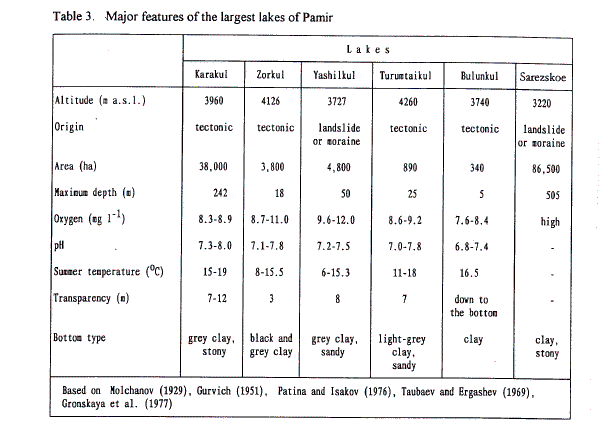
Water chemical composition in the lakes Sarezkoe, Zorkul, Yashilkul, Bulunkul, Turumtaikul, Kundzhingit and Chakankul is dominated by calcium carbonate. Total dissolved solids range from 130 to 200 mg l-1 (Gronskaya et al., 1977). Most lakes have stony bottom, with stones covered by clay sediments which accumulate at the mouths of entering rivers. Potamogeton, Chara, Ceratophyllum and Myriophyllum dominate the aquatic macrophytes. Diatoms, green and blue-green algae are the most common algae. Zooplankton reaches a biomass of 92.1 g m-3, zoobenthos 15.4 g m-2 (Table 4). In summer the lakes are rich in zooplankton, especially Cladocera, and zooplankton production may reach 600 kg ha-1 In shallows benthos is dominated by oligochaetes and chironomids, with a standing crop of 86.4 kg ha-1. The average weight of macrophytes is 5 t ha-1. The Pamir high altitude lakes have a medium productivity.
4.2 Major fish species
Pamir lakes are inhabited by only a small number of fish species. The indigenous are: false osman (Schizopygopsis stoliczkai), snow trout or marinka (Schizothorax intermedius), Tibet stone loach (Noemacheilus stoliczkai), karakul stone loach (Noemacheilus lacusnigri). The following two species were introduced: giebel carp (Carassius auratus gibelio) and northern whitefish (Coregonus peled).
Marinka is a typical fish of the Pamir rivers and lakes up to 3900 m altitude. It grows to 50.3 cm and a weight of 2 kg. It spawns in June/July at temperatures of 11.0-14.2oC. When 35-50 cm long, females produce 13,000-27,260 eggs, which are deposited in shallows on stones, gravel and sand. Marinka forms shoals for overwintering. It may not spawn every year. It feeds on algae such as diatoms, and on molluscs and chironomid larvae (Grishchenko, 1983). This fish has tasty flesh, but poisonous eggs. It is a favourite angling fish.
Tibet stone loach, of no commercial importance, is a common fish in Tajikistan where it is present up to 4500 m altitude. It appears in the littoral of the majority of Pamir lakes. It grows to 19 cm and in high-mountain lakes it matures at a body length of 5.2-6.4 cm. It spawns in May/June at a temperature of 9-12oC. Mature females of 10-14 cm lay 1635-5036 eggs in shallow depressions on sandy substrate and cover the eggs with sand. The fish feed on benthos and plant detritus (Grishchenko, 1983).
Karakul stone loach is an endemic species of Lake Karakul, from where it enters the mouths of the inflowing streams. It matures at the size of 5.2 cm, the spawning lasts 10-42 days. Most of the brood stock die after spawning. The fecundity is 430-2600 eggs per female. The egg incubation period is 8-10 days. The fish feed on chironomid larvae and detritus. While of no fishery importance, the fish is eaten by birds (Grishchenko, 1983).
In 1967, 37,000 giebel carp yearlings were released in Lake Bulunkul. Today the species is also present in Lake Yashilkul where it migrated from the River Uzyuk which connects these lakes. In summer giebel carp gather in the densely vegetated littoral of the lakes. The fish reaches a length of 32 cm and a weight of 1 kg. The fecundity is 48,250 to 161,000 eggs. Giebel carp feed on crustaceans, molluscs, chironomid larvae and detritus. This fish represents about 1% of the total fish catch from these lakes.
False osman is the most common species in the rivers and lakes of the Pamir at an altitude of 1650 to 4400 m. It reaches a body length of 65 cm and a weight of 4.5 kg, or even more. It appears in a lake and a river form, which differ in feeding habits. In the small and shallow Lake Bulunkul, overgrown with aquatic macrophytes, the fish feed on periphyton and higher aquatic plants. In Lake Sarezskoe, which is a deep lake formed in 1911, with a very narrow belt of littoral vegetation, there are two forms of false osman: one with predatory habits, the other phytophagous. In Lake Yashilkul, older than Lake Sarezskoe but also deep, four feeding types of false osman are found: benthos-feeding, plant-feeding, mollusc-feeding, and predatory type. This differentiation into types on basis of feeding habits, which signifies the beginning of a speciation process, shows the adaptability of osman to the extreme conditions of high mountain lakes of the Pamir. The absence of other competitive fish species seems to facilitate such a process (Savvaitova et al., 1987, 1988).
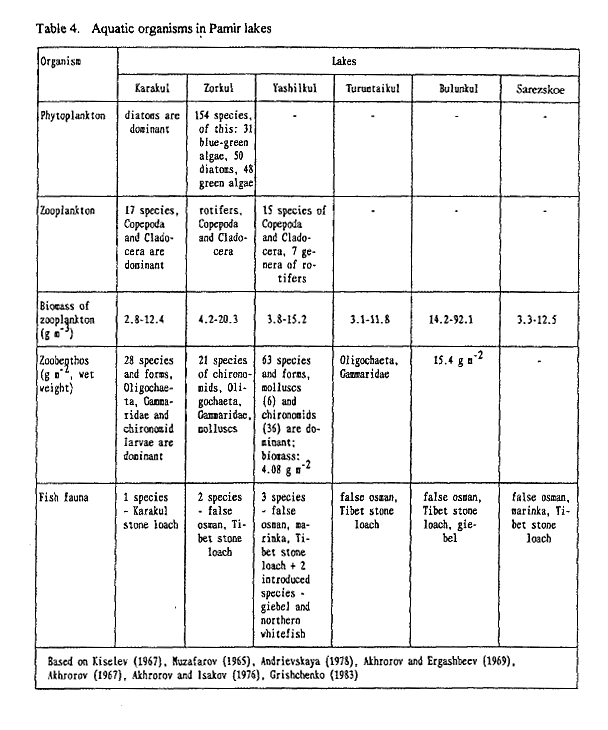
4.3 Existing fishery and future fishery potential of Pamir lakes
Only a few figures exist for fish catches from the Pamir lakes (Table 5). False osman (85-90% of the total) is by far the major fish species captured in Pamir lakes, followed by marinka and giebel carp. Catches may vary from year to year. Most fish are captured in shallows down to 2.5 m depth. The reason for the variation in catches is the absence of commercial fisheries in many lakes, and the irregular exploitation of the fish in others.
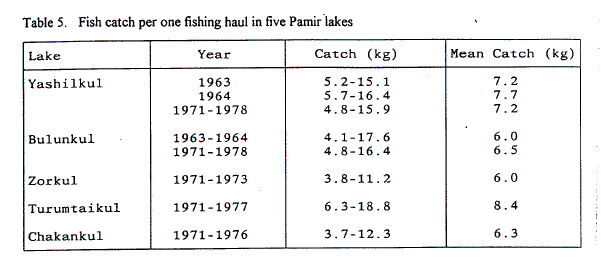
Bottom set nets (40-55 mm mesh size) appear to be the most effective fishing gear. The most productive lakes are Yashilkul, Bulunkul, Turumtaikul and Zorkul. During summer and autumn it is estimated that 7-10 t of fish are captured in Lake Bulunkul, which has a surface area of 340 ha. This represents a yield of 21.2-29.6 kg ha-1; in Lake Yashilkul the corresponding figures are 65-94 t (area 2880 ha, yield 22.8-32.8 kg ha-1); in Lake Zorkul 46-58 t (area 2280 ha, yield 20.4-25.6 kg ha -1) in Lake Turumtaikul 18-21 t (area 534 ha, yield 33.6-39.6 kg ha-1). The total commercial catch is approximately 180 t yr-1. This yield could probably be increased through regular stocking and introduction of the fast growing Siberian whitefish (Coregonus lavaretus). Even if its introduction does not lead to an increase in production, it would result in conversion of the existing fish food resource into a better final product. Pamir lakes offer good conditions for fish feeding on zooplankton. There is a programme to introduce northern whitefish in Lake Yashilkul by releasing one million larvae of this fish annually over a period of 4-5 years. The full utilisation of zooplankton would increase the fish yield by 19 kg ha-1 (Grishchenko, 1983). The first 1.5 million larvae produced by the Karakul hatchery were released in Lake Yashilkul in 1979-1980. Subsequently, the fish have been found well spread throughout the lake, feeding on zooplankton and growing fast. In six months the fish reached a weight of 300-342 g, at the age of two years they weighed 684 g with a length of 44 cm, and at the age of three years 890 g. Other water bodies in the Pamir are also to be stocked with whitefish in the hope of achieving an annual total catch of 300-400 t (Grishchenko, 1986).
The other species proposed for introduction in Pamir lakes is the Arctic char (Salvelinus alpinus erythrinus) (Savvaitova et al., 1988). It is proposed to stock this rare and endangered Trans-Baikal char in inaccessible high-mountain water bodies where it would be kept in a sanctuary of its own.
High mountain lakes of Pamir and Tien Shan in Central Asia formed during the Quaternary. The original fish fauna of these lakes comprised fish species of the upper courses of mountain rivers. The existing fish fauna of the high altitude coldwater bodies of the Pamir has historical connection with the fauna of the high altitude watersheds of Afghanistan, Pakistan, India and Nepal. Tectonic processes and glaciation played an important role in the formation of the fish fauna (Nikolsky, 1938). The common features of the fish fauna in the high mountains of Central and Southern Asia are their low species diversity, endemism, and a number of morphological and anatomical adaptations which help the fish to tolerate the harsh high-altitude conditions.
Fishery managers have been faced with an increasing demand for more fish for markets. However, coldwater bodies have an inherently low productivity, and consequently the indigenous and some endemic fish species give low yields. This has led to introductions of additional fish species, more productive than those in the lakes and rivers, and faster growing, which would better utilise the existing food base and therefore give higher yields. Placement of additional fish species has depended on whether there was a vacant niche which a suitable fish species could occupy. Any new introduction would also have to be capable of tolerating the harsh conditions of coldwater high mountain lakes, as well as being a species with fishery value, either as food or for anglers. An additional requirement would be that it does not compete with the indigenous, and especially endemic fish species. However, in the past this condition was not considered to be of high importance, as is well documented in the case of Lake Issyk-kul. There the introduction of the piscivorous Sevan trout was done with full understanding of its character and with the purpose of better utilisation of the existing fish stock which were not considered of such high quality as Sevan trout.
Decisions to introduce fish in new reservoirs established on coldwater rivers were easier to make as in such reservoirs the original riverine fish species were usually doing poorly, therefore the transferred lacustrine species did not compete with the indigenous fish fauna.
The three types of coldwater bodies discussed in this paper show the diversity of problems faced by fishery managers. In the case of the River Chu in Kyrgyzstan/Kazakhstan, the demands for water for irrigation and hydropower production clearly dictate a strategy which calls for fish production based on hatchery produced stocking material, either to be released in reservoirs, or used for pond fish production. In Lake Issyk-kul, where the Sevan trout led to a drastic decline in several endemic fish species, and subsequently also to the decline in the Sevan trout itself, the only remedy was to introduce planktivorous coregonids in order to balance the losses in the yield. In Pamir lakes, where fishing pressure is still very low, the introduction of coregonids is being contemplated for the purpose of increasing yields. At the same time, however, it is recognised that some lakes could serve as sanctuaries for the preservation of coldwater fish species which are threatened in their original habitat.
Akhrorov, F.A. 1967. Evaluation of benthos in Pamir lakes (Yashilkul and Bulunkul). Izv. AN Tajik. SSR, Otd. Biol. Nauk (Dushanbe) 2(27): 64-73. (In Russian).
Akhrorov, F.A. and I. Ergashbeev. 1969. Zoobenthos of some shallow water bodies in the watershed of Lake Zorkul (Pamir). Izv. AN Tajik. SSR, Otd. Biol. Nauk (Dushanbe) 4(61): 36-42. (In Russian).
Akhrorov, F.A. and U. Isakov. 1976. General hydrological and hydrobiological characteristics of some Pamir lakes. Biol. Osnovy Ryb. Khoz. Respublik Srednei Azii i Kazakhstana: 41-43. Ilim, Frunze.(In Russian).
Andrievskaya, C.A. 1978. Phytoplankton of Lake Karakul (Pamir). Biol. Osnovy Ryb. Khoz. Respublik Srednei Azii i Kazakhstana: 16-17. Ilim, Frunze. (In Russian).
Artemev, V.V., R.K. Klinge and A.O. Selivanov. 1992. History of formation of water resources and fluctuations in water level of Lake Issyk-kul in late Pleistocene and Holocene. Vodnye Res. No.4: 71-78. (In Russian).
Berg, L.S. 1929. Fisheries in Issyk-kul. Izv. Inst. Opytnoi Agronomii (Moskva) 7: 179-181. (In Russian).
Berg, L.S. 1930. The present state of fisheries in Issyk-kul. Issykkulskaya Ekspeditsia 1928 g. 1: 1-48. (In Russian).
Berg, L.S. 1949. Freshwater fishes. AN SSSR. Moscow and Leningrad. Vol. 2: 478-925. (In Russian).
Borisov, S.I. 1981. Induced reproduction of trout in Issyk-kul. Biol. Osnovy Ryb. Khoz. Vodoemov Srednei Azii i Kazakhstana: 40-42. Ilim, Frunze. (In Russian).
Dukravets, G.M. 1992. The Amur snakehead, Channa argus warpachowskii in the Talas and Chu River drainages. J. Ichthyol. 32(2): 147-151.
Dukravets, G.M. and R.Sh. Mamilov. 1993. Morphometric and biological data on percids of the Chu River basin. J. Ichthyol. 33(3): 76-85.
Foliyan, L.A. 1981. Zooplankton of Lake Issyk-kul. Biol. Osnovy Ryb. Khoz. Vodoemov Srednei Azii i Kazakhstana: 389-390. Ilim, Frunze. (In Russian).
Grishchenko, E.V. 1983. Biology and importance of scaleless osman and ways of increasing fish production in Pamir water bodies. Moscow (thesis). 150pp.(In Russian).
Gronskaya, T.P. et al. 1977. Hydrometeorological regime of the Lake Sarezskoe basin. Trudy Gos. Gidrolog. Inst. (Leningrad) 246: 34-57. (In Russian).
Gurvich, V.F. 1951. On the productivity of Pamir lakes. Sredneaziat. Gos. Univ. (Tashkent) 24(9): 59-68. (In Russian).
Ivanova, L.M. 1986. Distribution of mysids in Lake Issyk-kul. Biol. Osnovy Ryb. Khoz.. Vodoemov Srednei Azii i Kazakhstana: 65-66. Ilim, Ashkhabat. (In Russian).
Kadyrov, G.K. 1986. Hydrochemistry of Lake Issyk-kul and its basin. Ilim, Frunze. 212pp. (In Russian).
Kiselev, V.I. 1967. Algae of Lake Karakul (Pamir). Sporovyje Rastenia 5: 67. Leningrad. (In Russian).
Kodyaev, G.W. 1973. Morphometric characteristics of Lake Issyk-kul. Izv. Vsesoyuz. Geogr. Obschestva 105(4): 362-65. (In Russian).
Konurbaev, A.O. 1981. Decrease in biological productivity of Lake Issyk-kul due to the declining water level. Biol. Osnovy Ryb. Khoz. Vodoemov Srednei Azii i Kazakhstana: 100-103. Ilim, Frunze. (In Russian).
Kurdin, R.D. 1991. The causes of the declining water level in Lake Issyk-kul and predictions of future changes. Vodnye Res. No.3: 46-56. (In Russian).
Leontiev, S.A. and D.V. Sevastyanov. 1988. Problem of managing Issyk-kul water level. Vodnye Res. No.1: 121-128. (In Russian).
Molchanov, I.V. 1946. Lake Issyk-kul. Gidrometeoizdat, Leningrad. 53pp. (In Russian).
Molchanov, L.A. 1929. Lakes of Central Asia. Trudy Sredneaziat. Gos. Univ., Geografiya, 3: 26-31. Tashkent. (In Russian).
Muzafarov, A.M. 1965. Algae in water bodies of Central Asia. FAN, Tashkent. (In Russian).
Nikitin, A.A. 1976. Introduction and induced reproduction of whitefish in Kirgizia.. Ilim, Frunze. 122pp. (In Russian).
Nikolsky, G.V. 1938. Fishes of Tajikistan. AN SSSR, Moscow and Leningrad. 228pp. (In Russian).
Patina, D.L. and U. Isakov. 1976. Ionic content in water of Lake Zorkul (Pamir). Materialy po Rybokhoz. Osvoeniyu Vodoemov Srednei Azii i Kazakhstana: 137-138. Donish, Dushanbe. (In Russian).
Petr, T. and V.P. Mitrofanov. 1998. The impact on fish stocks of river regulation in Central Asia and Kazakhstan. Lakes & Reservoirs: Research and Management 3:
Savvaitova, K.A. and T. Petr. 1992. Lake Issyk-kul, Kirgizia. Int. J. Salt Lake Res. 1(2): 21-46.
Savvaitova, K.A., A.Yu. Shanin and V.A. Maksimov. 1987. On intraspecific differentiation of the osman Schizopygopsis stoliczkai in Pamir water bodies. Vestnik Mosk. Univ., Biologiya 16(2): 9-17. (In Russian).
Savvaitova, K.A. et al. 1988. Problem of conservation and gene pool of rare fish species in waters of Baikal region (on the example of char Salvelinus alpinus). Problemy Ekologii Pribaikalya: 140-141. Vostochno-Sibir. Pravda, Irkutsk. (In Russian).
Sevastyanov, D.V. and N.P. Smirnova. 1986. Lake Issyk-kul and trends in its natural development. Izd. Nauka, Leningrad. 246pp. (In Russian).
Shabunin, G.D. 1981. Thermodynamic processes in Lake Issyk-kul. Biol. Osnovy Ryb. Khoz. Vodoemov Srednei Azii i Kazakhstana: 394-396. Ilim, Frunze. (In Russian).
Shnitnikov, A.V. 1979. Lake Issyk-kul: nature, conservation and the prospects for lake utilization. Ilim, Frunze. 84pp. (In Russian).
Taubaev, G.G. and A.E. Ergashev. 1969. Vegetation of the high-mountain Lake Zorkul (Pamir): 164-172. FAN, Tashkent. (In Russian).
Turdakov, F.A.1954. On the development of fisheries in Lake Issyk-kul. Trudy Inst. Zool. Parazitol. Kirgiz. Fil. AN SSSR 2:31-38. Frunze. (In Russian).
Turdakov, F.A. 1961. Reconstruction of fisheries in Lake Issyk-kul. Vestnik AN SSSR 2: 54-56. (In Russian).
Turdakov, F.A. 1963. Fishes of Kirgizia. Ilim, Frunze. 283pp. (In Russian).
Tsitsenko, K.V. and V.V. Sumarokova. 1990. Hydrobiological principles of irrigation systems. Gidrometeoizdat, Leningrad. 331pp. (In Russian).
Zabirov, R.D. 1978. Relief of the lake. In: Ozero Issyk-kul: 49-58. Ilim, Frunze.(In Russian).
Zabirov, R.D. and V.N. Korotaev. 1978. Characteristics and morphometry of the lake: In: Ozero Issyk-kul: 3-48. Ilim, Frunze. (In Russian).
Zektser, I.S., P.I. Chalov, M.I. Kaplinsky, U.U. Usmanov, G.G. Bergelson, A.V. Meshkheteli, A.I. Tikhonov, B. Imankulov and O.S. Krivchenko. 1988. Groundwaters of the Priissykkulye and their rational use. Ilim, Frunze. 204pp. (In Russian).
1 Geographical names in tables may have different spellings than those in the text. This is because the tables were typed before the text terminology was standardized.